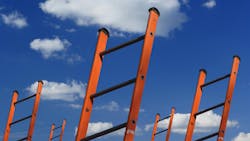If you open 29CFR 1926 and turn to Subpart X, you will see the third subpart is 1926.1052. This provides the requirements for stairways. But our focus here is on ladders, so we skip to the fourth subpart, which is 1926.1053.
Subpart 1926.1053 consists of (a)(1) through (27) and (b)(1) through (22). The sheer size of this explains much of the nonconformance. OSHA needs something specific to cite you on — thus the verbosity. However, it appears that OSHA generally might be more concerned that you follow ladder safety concepts. How so?
Look at how this is organized. 1053 (a)(1) through (27) is about the ladders themselves and (b)(1) through (22) is about their use.
As you read down the requirements presented in 1053 (a)(1) through (27), you won’t find anything resembling rocket science. It starts off by telling you what loads a ladder must be capable of supporting without failure. An easy way to conform this for portable ladders is to have only industrial-grade ladders. The same logic applies to several other requirements, such as the rungs must be parallel and meet specific spacing/shape requirements. For fixed ladders, you do need to go down the list and ensure each requirement is met.
Most of these requirements are for fixed ladders, and a few of these are not intuitively obvious. For example, when the total length of a climb is 24 feet or more, fixed ladders must be equipped with at least one of three listed safety devices. It’s in these particulars where a well-intended yet not well-versed employer is likely to get cited. While it may seem tedious to go through this list, these are requirements you apply one time: when you build, install, or purchase the ladder.
The one and done motif does not apply to (b)(1) through (22). For example, ladder maintenance is considered part of ladder use. Ladders must be maintained free of oil, grease, and other slipping hazards. This list of 22 requirements needs ongoing attention. You may comply one moment and violate in the next.
You may get cited not just for what your company does wrong but also for what your employees do wrong. Nearly everything in this list falls under that rubric. For example, the top or top step of a step ladder shall not be used as a step. It says this right on the ladder, and yet OSHA finds people doing this. They cite the company for it even though no manager instructed an employee to do it. Why? Because the company has the obligation to provide ladders of sufficient height, train employees in correct ladder usage, and supervise its employees.
You can think of 1053 (a)(1) through (27) as a management issue for ladder acquisition and installation. You can think of 1053 (b)(1) through (22) as a management issue for ensuring employees know how to correctly use ladders and are, in fact, using them correctly.
About the Author

Mark Lamendola
Mark is an expert in maintenance management, having racked up an impressive track record during his time working in the field. He also has extensive knowledge of, and practical expertise with, the National Electrical Code (NEC). Through his consulting business, he provides articles and training materials on electrical topics, specializing in making difficult subjects easy to understand and focusing on the practical aspects of electrical work.
Prior to starting his own business, Mark served as the Technical Editor on EC&M for six years, worked three years in nuclear maintenance, six years as a contract project engineer/project manager, three years as a systems engineer, and three years in plant maintenance management.
Mark earned an AAS degree from Rock Valley College, a BSEET from Columbia Pacific University, and an MBA from Lake Erie College. He’s also completed several related certifications over the years and even was formerly licensed as a Master Electrician. He is a Senior Member of the IEEE and past Chairman of the Kansas City Chapters of both the IEEE and the IEEE Computer Society. Mark also served as the program director for, a board member of, and webmaster of, the Midwest Chapter of the 7x24 Exchange. He has also held memberships with the following organizations: NETA, NFPA, International Association of Webmasters, and Institute of Certified Professional Managers.
